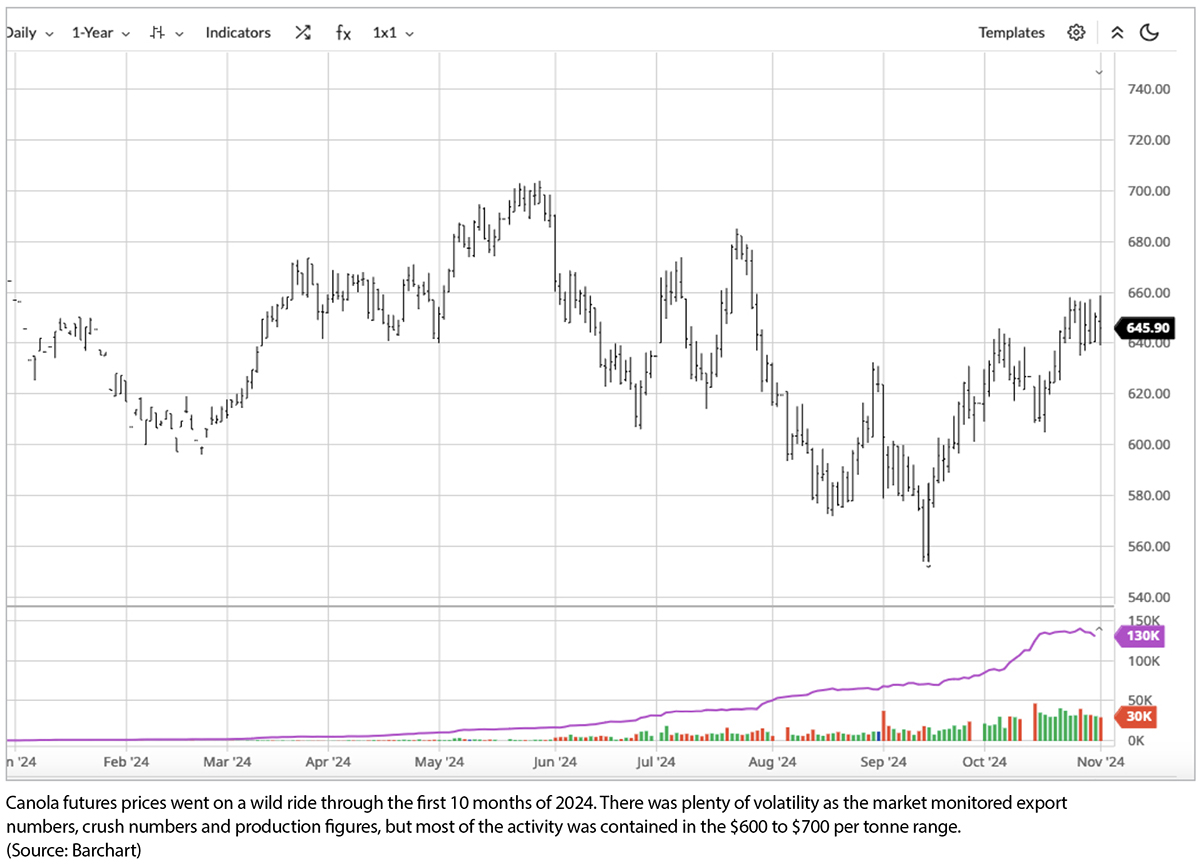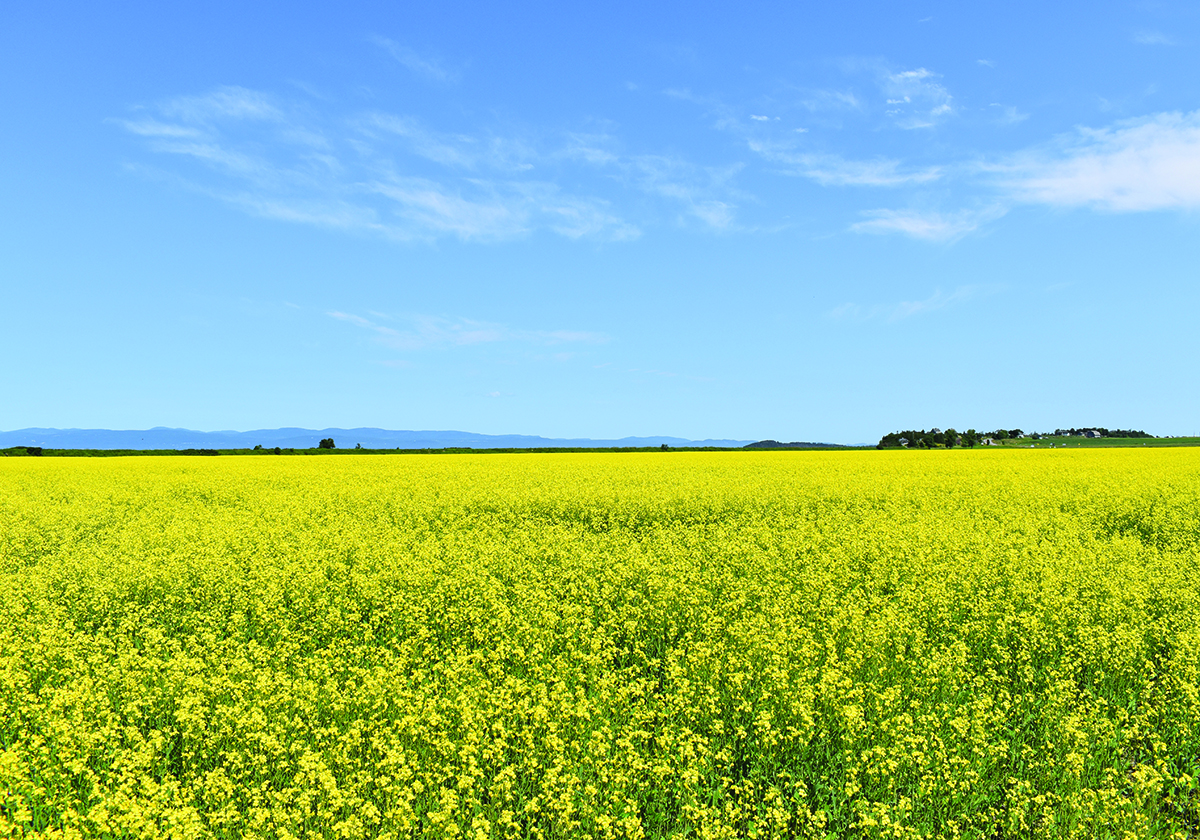Canada loses market share to Australia in traditional markets such as Japan, Mexico and the European Union
Canola futures traded in the range of $600 to $700 per tonne for the first 10 months of 2024.
It was a wild ride with fund managers holding the reins. They held a net short position in canola futures the entire time, keeping a lid on prices.
Other stories in the Canola Yearbook 2024:
- A new era for crop genetics
- Canola goals must be reassessed to match market reality
- Canola growing season in review
- Canola remains a Prairie economic powerhouse
- Bill C-234 ping pongs between Senate and House
- Canola News Briefs
- Verticillium, blackleg and gophers
- Sustainability incentive for canola growers
- What made canola so strong?
- Science news briefs
- Tiny allies may help withstand drought
- Canola and climate change in Western Canada
- Production news briefs
- The future of gene editing in canola
- Canola views – photo essay
Their net short position ranged from a record high of about 150,000 contracts in March, down to 50,000 in May, then back up to 150,000 in August and then climbing toward 60,000 by the end of October.
Read Also

New wheat varieties offer Prairie farmers jump in yield
Three experimental wheat varieties developed by Agriculture Canada are showing yield increases of eight to 15 per cent over AAC Brandon wheat in registration trials.
Canola prices largely followed suit, hitting the lows when the net short positions were high and rebounding when they were low.
The crop started 2024 in the middle of a steep downward slide due in part to a lacklustre export program.

Chuck Penner, analyst with LeftField Commodity Research, told growers attending the annual general meeting of Saskatchewan’s crop organizations in January that there was still time for the crop to recover from the dismal start to the 2023-24 crop year.
At the time of his presentation in mid-January, exports were running about one million tonnes behind the pace needed to meet Agriculture Canada’s 7.7 million tonne target for the crop year.
His advice to canola growers was to wait it out a little longer because China is an unpredictable buyer and things can change in a hurry.
“I wouldn’t be panicking about the canola market yet,” said Penner.
He noted that domestic crush was running 350,000 tonnes ahead of Agriculture Canada’s estimated pace and would likely reach 11 million tonnes by the end of the year.
Penner’s remarks turned out to be prescient.
A couple of weeks later news broke that China had gone on a shopping spree, purchasing one million tonnes of Canadian canola for delivery in the March through May period.
But that bit of bullish news wasn’t enough to halt the downward price slide because China was acting as a price-setter rather than a price-taker at that time.
“I don’t think they’re going to chase the market higher,” MarketsFarm analyst Mike Jubinville said in a late-January interview.
“I think they’ve given us a price and said, ‘take it or leave it,’ and we took it.”
He warned that the days of $1,000 per tonne canola futures are long gone. That was the result of a perfect storm of events, including the global pandemic, the 2021 drought and soaring renewable diesel demand.
Jubinville said the market “over-exaggerated crazily” to the upside during that time and was probably doing the same thing to the downside at the start of 2024, although he didn’t think the market had cratered just yet at the time of his January interview.
He was right. The market continued to fall until it bottomed out at $600 per tonne in late February.
Canola’s fortunes changed at the start of March, with futures prices climbing $100 per tonne over the next three months.
There was some foreshadowing of the bull run when analysts at the annual U.S. Commodity Classic conference in early March started sounding bullish about soybean prospects.
“I don’t know if we’re at the bottom of the market, but we’re close,” said Al Kluis, a trader with Kluis Commodity Advisors.
The soybean market indeed bottomed out and started to climb, taking canola along for the ride.
Canola prices were also propped up by a poor early prognosis for the 2024 growing season.
Curtis Rempel, vice-president of crop production and innovation with the Canola Council of Canada, provided a grim early-season report during his March presentation at the council’s Canola Utilization Forum.
He put up a map showing that soil moisture was 40 to 85 per cent of normal in a big circle encompassing Edmonton, Calgary and Saskatoon.
“Large swaths of the Prairies, especially parts of our highly productive black soil zones, are still well below normal soil moisture levels,” said Rempel.
Another map showed 85 per cent of the Prairies was experiencing moderate to exceptional drought as of the end of February.
Jubinville was sensing a transition from a bear market to a bull market by late March, saying he was reasonably optimistic farmers might see some $15 per bushel canola prices over the course of the spring.
Managed money funds had just come off the largest net short position in the history of canola futures.
“That in itself kind of opens the door for at least some corrective bounce potential and in the last month we’ve certainly seen some of that,” Jubinville said during a spring webinar.
But there were still lingering concerns about exports.
Marlene Boersch, managing partner of Mercantile Consulting Venture, noted that Canada had shipped out 4.24 million tonnes of canola through week 36 of the 2023-24 campaign, compared to 6.25 million tonnes for the same period a year ago.

She said Canada was losing market share to Australia in traditional markets such as Japan, Mexico and the European Union.
“Crush is saving us, but on exports we’ve done extremely poorly this year,” she said.
Crush margins were being propped up by high crude oil prices.
Canola was also getting a lift from concerns about floods in Brazil hurting that country’s soybean crop.
In May, Agriculture Canada increased its estimate for 2024-25 canola ending stocks to 2.5 million tonnes, up from 1.65 million tonnes a month earlier.
That was due to an increase in carry-in caused by the poor 2023-24 export program.
Agriculture Canada kept its 2024-25 production numbers unchanged, but analysts started bumping theirs up.
Mercantile moved its number to 19.47 million tonnes in May, well above Agriculture Canada’s 18.1 million tonnes due to good growing conditions.
Canola futures peaked at about $700 per tonne at the end of May and then began to tumble due to the larger carryover and improved production prospects.
MarketsFarm analyst Bruce Burnett was forecasting a “close-to-record crop” on the Prairies at the Ag in Motion show in mid-July.
He predicted an average canola yield of 42 bushels per acre and 20.6 million tonnes of production, a 2.3 million tonne improvement over the previous year.
Burnett wasn’t the only one gushing about crop prospects at the show. Stephen Nicholson, global sector strategist of grains and oilseeds for Rabobank, raved about Canada’s crops.
“Driving the countryside this week, there’s unbelievable looking crops, and the canola is gorgeous,” he said.
But Burnett provided some foreshadowing, warning that the heat forecast for the second half of July was “worrisome.”
By the end of July everything had changed. There were reports that the European Union’s crop was going to be 2.4 million tonnes smaller than the previous year due to excess moisture in France and Germany.
Canada’s crop was in trouble as well with provincial crop ratings plummeting in Alberta and Saskatchewan due to heat blast.
Burnett pulled out his eraser by the end of July, dropping his canola yield estimate by two bu. per acre, taking his production number to 19.5 million tonnes.
“It’s almost like it has been a flash drought on the Prairies,” he said.
He was still forecasting a decent crop, but any notion of a bumper crop had been erased by the late-July heat blast.
However, canola futures continued to fall in August despite the changing fortunes of the crop, weighed down by forecasts of a record U.S. soybean crop.
Canola prices dipped below $600 per tonne in late August for the first time in the calendar year.
Prices began to rally in mid-August but came crashing back down after China announced Sept. 3 that it was launching an anti-dumping investigation into canola seed imports from Canada.
Penner noted at the time that the news could prove to be bullish in the short term as Chinese crushers scramble to get their hands on the oilseed before import duties are applied.
“It’s possible that we see a boom in canola exports,” he said.
“We could conceivably move a million tonnes or more in the first quarter to China.”
The market did not appear to agree with him — at least initially.
Canola futures hit a 2024 low of close to $550 per tonne in mid-September before once again rallying about $100 per tonne.
The rally started when Statistics Canada lowered its 2024-25 production estimate to 18.9 million tonnes, down from its earlier forecast of 19.5 million tonnes.

It gained steam when it became clear China was indeed going on another shopping spree, even before its anti-dumping investigation announcement.
The country purchased 718,000 tonnes of canola in August, the best start to Canada’s Chinese export program on record.
Burnett said China was bolstering its oilseed supplies due to tightness in the palm oil market and a disappointing domestic rapeseed harvest.
By the end of October there were reports that Canada’s production could fall as low as 17 million tonnes based on provincial crop yield estimates from Alberta and Saskatchewan.
Canada’s record start to the 2024-25 export program and the ever-shrinking production estimate propelled canola futures back up around $650 per tonne by the end of October.
Exports totalled 2.9 million tonnes through week 12 of the 2024-25 crop year, compared 1.3 million tonnes a year earlier, causing some to question Agriculture Canada’s full-year forecast of 7.5 million tonnes.
Canada’s balance sheet was getting tight. The only thing keeping prices in check as of the end of October was the large U.S. soybean crop and improving South American production prospects.
Contact sean.pratt@producer.com
















